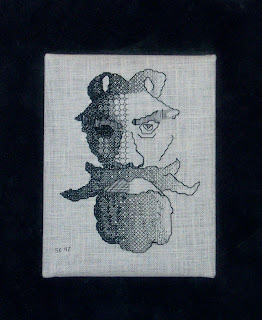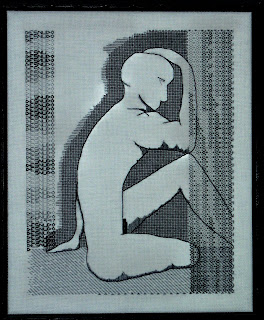
Persimmons and Teapot
colored pencil sketch
17 December 2007
When I decided to be a professional embroidery teacher and designer in the early 80s, I tried to equip myself with the tools I needed to be effective. I studied every type of embroidery I could with the best teachers I knew of. I looked at those teacher's written instructions; I learned how to use a computer and word processing software; and I practiced illustrating stitch diagrams. This served me for a long time and I was more successful as a teacher than I had ever expected to be.
All along not only was I stitching pieces for teaching, but I was also stitching pieces for my own enjoyment and explorations. I would enter the odd piece into art shows. It was while I was living in England, teaching there and also taking classes there, that I realized that I needed something more than what I was doing in order to really move ahead. It was around this time that I thought I could be an artist. I started studying design theory. Now I had already had an Individual Correspondence Course in design from EGA by Ann Harris and an ICC in color from Wilana Bristow, so I had some experience. But I really started to study design theory (color theory is just a part of design theory). The best way to study design is to teach it. Things were going pretty well. I was teaching a lot of color and design in and out of EGA. I was learning tremendous things about my own work and how to improve it. But I needed more.
Have you ever had anyone tell you that as an artist or even as a designer, you need to know how to draw? People kept telling me this. But, really, I didn't need to know how to do that. I was a needlework designer and that doesn't need drawing. After all, look at my blackwork--done without formal training in drawing. Grotesque was done without a drawing or a graph. He was named after all the sculpture on buildings in England and France called gargoyles. A grotesque is a gargoyle without a waterspout.

Grotesque
Blackwork with silk thread on 32 count linen
stitched freehand
In September of 1996 I finally did what my mentors told me I would have to do: I enrolled in a beginning drawing class at my local community college in Littleton, Colorado. I was the oldest one in class including the instructor. I went to every class, I did all the assignments, and I learned. The nineteen-year-olds were all more experienced with the art of the pencil than I was, but I was certainly the most motivated. I came out a new person. Drawing doesn't so much teach a person how to use a pencil, it teaches a person how to SEE. I learned about shadows and edges, one-, two-, and three-point perspective. I learned how to draw the least little detail for authenticity in the drawing. The last class was a live model class and drawing the nude was a special treat. Out of this class meeting came Desnudo. Something I DREW.

Desnudo
Blackwork in silk thread on 28 count linen
from a live model
And so I am telling you now that in order to be a good artist, no matter how talented you might be on your own, you have to learn to draw. Since December 1996 when I left the class, I have been drawing. Certainly not every day, but there have been months when it has been just that. I draw as a treat and my drawings are a body of work apart from my needlework. I do colored pencil drawings, like the one here.
Because of my drawing, I have a lot more confidence in my work. I have a lot more authority in my teaching design and color theory. Learning to draw was such a gift that I gave myself--opening up a side of me that I didn't know existed. So--Learn To Draw!
No comments:
Post a Comment